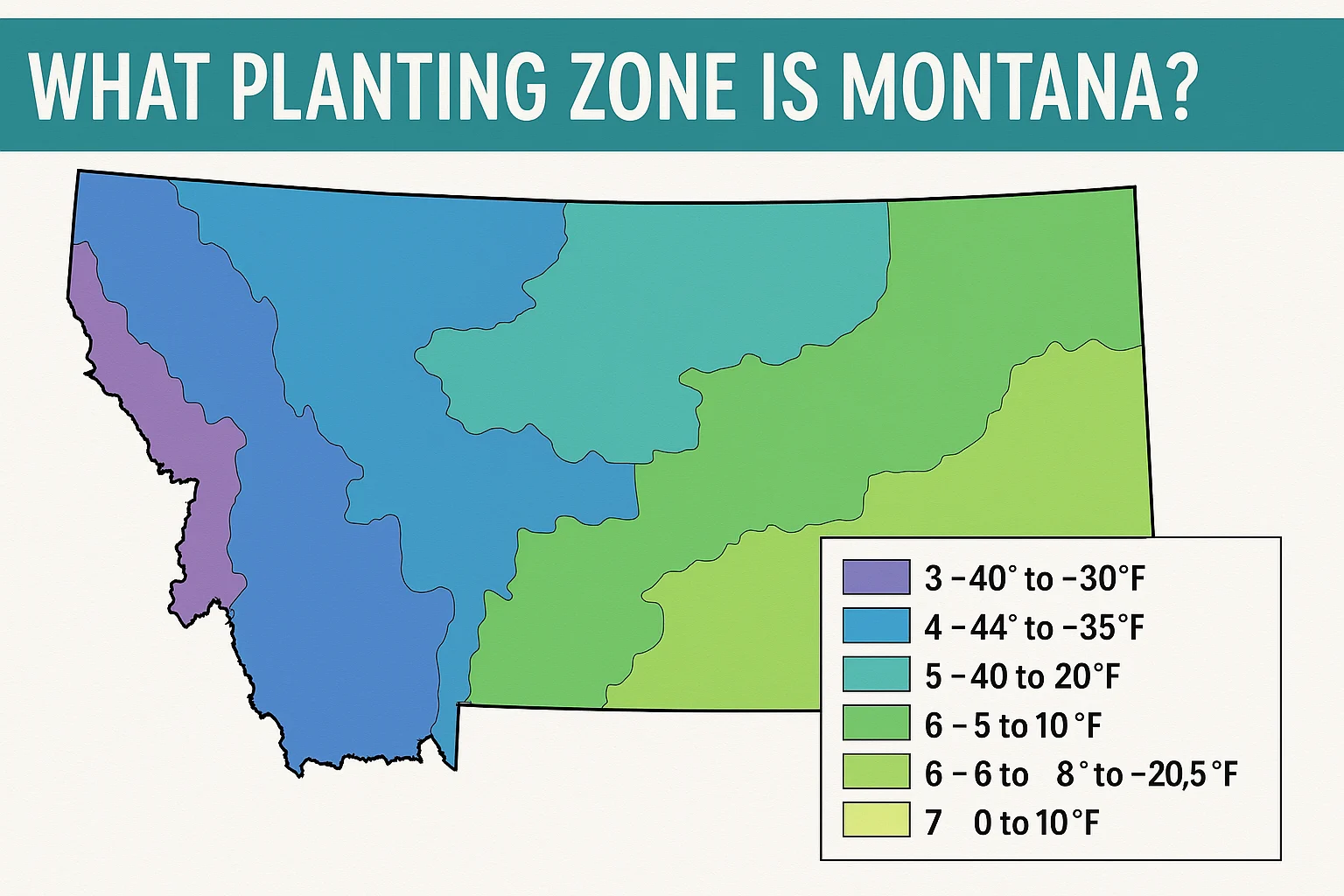What Planting Zone is Montana?[Map, Cities, and Growing Tips]

If you’re planning a garden or landscaping project, knowing what planting zone is Montana is essential. This simple number determines which plants will survive the state’s harsh winters and grow successfully throughout the seasons.
Montana’s diverse elevations and climates create a wide range of planting zones. In this guide, we’ll explain what planting zone is Montana, how it affects your planting choices, and share practical tips for gardening in Big Sky Country.
What Planting Zone is Montana?
Montana spans USDA Plant Hardiness Zones 3a to 6b. This variation is mostly due to the state’s diverse geography, from high mountain ranges to low valleys and plains.
| Region | USDA Planting Zone |
|---|---|
| Western Montana (Missoula, Kalispell) | Zone 5a–6b |
| Central Montana (Helena, Great Falls) | Zone 4b–5b |
| Eastern Montana (Billings, Miles City) | Zone 4a–5a |
| High Elevation & Northern Regions | Zone 3a–4a |
For gardeners, understanding what planting zone is Montana helps determine which perennials, shrubs, and trees will withstand your local winters.
📍 Montana Planting Zones by City
| City | Planting Zone |
|---|---|
| Billings | Zone 5a |
| Bozeman | Zone 5b |
| Helena | Zone 5a |
| Great Falls | Zone 4b |
| Missoula | Zone 6a |
| Kalispell | Zone 5b |
| Butte | Zone 4b |
| Miles City | Zone 4a |
| Livingston | Zone 5b |
The closer you are to the mountains or higher elevations, the colder your zone tends to be. This means your neighbor across town might be in a slightly warmer or colder zone.
🌡️ Why Knowing your Montana Planting Zone Matters?
Montana’s winters are no joke. Temperatures in Zone 3a can dip to -40°F, while Zone 6b areas might see lows of -5°F. That’s a massive difference when selecting plants.
Knowing what planting zone is Montana helps you:
- Choose perennials that survive harsh winters
- Time your vegetable planting to avoid frost
- Select trees and shrubs suited to your microclimate
- Reduce the risk of plant loss due to cold snaps
Trying to grow a Zone 6 plant in a Zone 3 area without protection often leads to disappointment.
🧠 Real-World Example: Tomatoes in Montana’s Zones
If you’re in Zone 4a (Miles City), planting tomatoes requires careful timing and frost protection. You’d typically plant in late May or early June after the danger of frost has passed.
In Zone 6a (Missoula), you might get a head start in mid-May, and even consider cold-hardy varieties that produce earlier.
This is why knowing what planting zone is Montana is crucial — your planting schedule and plant selection depend on it.
📅 Montana Planting Calendar Basics
| Crop Type | Zone 3 Start | Zone 4 Start | Zone 5 Start | Zone 6 Start |
|---|---|---|---|---|
| Cool-weather crops (lettuce, spinach) | April | Late March | Mid March | Early March |
| Warm-weather crops (tomatoes, peppers) | Late May–June | Mid–Late May | Mid May | Early–Mid May |
| Perennials | Late April–May | April | March–April | March |
Always verify your local frost dates — Montana’s weather loves surprises.
💡 Gardening Tips for Montana’s Planting Zones
Montana’s growing conditions are unique. Whether you’re in Zone 3 or Zone 6, these tips will help:
✅ Do:
- Use raised beds to warm soil faster in spring
- Start seeds indoors to extend your season
- Choose cold-hardy varieties (especially perennials)
- Mulch heavily to insulate roots over winter
- Watch for sudden temperature drops even in late spring
❌ Avoid:
- Planting too early without frost protection
- Assuming one-size-fits-all for Montana — microclimates vary
- Forgetting windbreaks in open prairie zones (wind chill affects plants)
Understanding what planting zone is Montana allows you to navigate these challenges effectively.
📍 Find Your Exact Planting Zone in Montana
For the most precise information, check your zip code on the official USDA Plant Hardiness Zone Map. While general city zones help, local variations in elevation and exposure can shift your actual planting zone by half a level.
This is especially important for borderline plants that may survive in Zone 5b but struggle in a colder microclimate.
🧮 Helpful Tools for Montana Gardeners
Take your gardening success further with these free resources:
- Soil Volume Calculator – Know exactly how much soil you need for raised beds.
- Plant Spacing Calculator – Prevent overcrowding and maximize yield.
- Indoor Plant Watering Calculator – Perfect for your houseplants or container garden.
❓ Frequently Asked Questions
What is the coldest planting zone in Montana?
Northern and high-elevation areas of Montana fall into Zone 3a, where temperatures can reach -40°F in winter.
Can I grow fruit trees in Montana?
Yes, but you’ll need cold-hardy varieties like apples, cherries, and plums. Look for trees rated for Zones 3–5.
What planting zone is Montana for vegetables?
Most vegetable gardens in Montana are in Zones 4a to 5b, though some southern or urban areas fall into Zone 6a.
✅ Final Thoughts: What Planting Zone is Montana?
Understanding what planting zone is Montana is more than a technical detail — it’s your key to gardening success. From choosing perennials that survive brutal winters to knowing when to plant tomatoes, your USDA zone guides it all.
Whether you’re in the chilly heights of Zone 3 or the milder valleys of Zone 6, matching your plants to Montana’s unique climate ensures a thriving, resilient garden.
🌿 Ready to plan your garden? Start with your zone and grow from there.
